This is a guest post by Kirsty Rayburn, Solano County, California Chapter Leader for the Weston A. Price Foundation. Weston A. Price Foundation is a nonprofit, tax-exempt nutrition education foundation. Read our mission statement. . . Become a member and receive our lively and informative quarterly journal. Click here for a message from Sally Fallon Morell. Read our Dietary Guidelines here.
In addition to being a chapter leader for the WAPF, Kirsty is blessed to be the mother of three, and another six that call her ‘motha’! Her ministry is teaching people about real food and how important real food is for real health. This is her story of what they believed to be her husband’s brown recluse spider bite in May of 2008.
Brown recluse spiders (BRS) are generally found in the central Midwestern states, especially in Oklahoma, Arkansas and Missouri. We have been told by several ‘authority’ figures that BRS are not found in California. We beg to differ. This is our story of what we believe was a BRS bite.
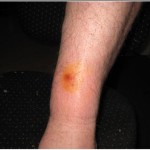
Day 3 - The night we went to Urgent Care. The orange mark in the center is due to an application of topical iodine.
Initially he thought he had a mosquito bite – it was red, itchy and bothersome. After a couple of days he brought the bite to my attention and we decided to visit Urgent Care at our HMO. By then, there was a distinctive bump, surrounded by dark edges and a large ‘bulls eye’ circle moving out on his leg. The skin was extremely hot to touch and the area around the bite was very hard and dry.
Our visit to Urgent Care did not go well. This was the first part of what led us to home treatment – we were assured that a) there were absolutely NO BRS in California and b) he was not suffering from any respiratory or skin distress (fever, shaking, rash, etc.), so clearly it was not a spider bite. For all intents and purposes we were sent home. We left and took treatment into our own hands.
I began by making a poultice of ground activated charcoal, tea tree oil, sage oil, and MSM powder. By bedtime that night the bite scene was beginning to swell and look very red. Colloidal silver was added as the mixing liquid for the poultice. Our main concern was to pull out the venom as fast as possible. The longer it was present the more necrosis (death of tissue) would occur. We also added bentonite clay into the poultice mix.
By this time I had done significant research on the Internet about BRS and their subsequent damaging bites. I knew we had to literally ‘throw everything we had and more’ at this to enable full healing for my husband. I found the “Brown Recluse First Aid Kit” from www.brown-recluse.com. I ordered the kit. It then became the basis of every poultice that we made. We stocked up on bandages (the soft stretchy gauze kind), non-stick sterile pads (imperative that non-stick is used due to the amount of weeping and oozing that the wound was doing) and bandage tape. When everything is changed at least three times a day you go through a LOT of supplies.
Much of the treatment was trial and error: soaking bandages with noni juice to lay on wound for 15 minutes after changing a poultice, using tamanu oil on the edges of the would (stopped due to irritation of the raw skin), stopping the colloidal silver and adding more lavender oil (it was reported to have prevented gangrene in WWI battlefield injuries). The wound was weeping copiously by day 6, and the poultice needed to be changed often (5 hours seemed to be the magic time frame). We followed this faithfully around the clock. The skin on the wound site was now extremely fragile and touching it seemed to just shred or dissolve the skin.
We started immune system building around this time as well – lots of Vitamin C, MSM and probiotics. The venom was clearly spreading and we wanted to build and strengthen the internal system as much as possible to fight any connection with the venom.
By day 7 we decided to remove the essential oils. The skin was so fragile and it was beginning to hurt…a lot. We used a marker and outlined the wound in order to track the changes. On day 8 we added approximately 1 teaspoon of coconut oil into the poultice mix. We also added zinc oxide to the very outer edges of the wound because the edges were getting very dry and tight. The zinc oxide seemed to relieve some of this tightness. By day 9 it was determined that not having it lower than the heart greatly reduced pain levels.
Our BRS first aid kit arrived on Day 10 and we added it immediately into the poultice mix. By now the wound was open, bubbly and clearly layers of skin were missing. Within 24 hours we started to see an improvement in the wound, although there was clearly some issues with edema (swelling) in his foot if he was standing too long.
We did have a couple of set backs along the way. For instance, if the poultice was left on too long it would dry out and have to be peeled / pulled from the wound. This removed more skin and was very painful. The other hiccup we had was around day 12 or 13. My husband started to itch…everywhere. 🙁 Soon after the itching started a rash followed. This was a head to toe rash that was unrelenting. We tried benedryl and prednisone but all to no avail. By day 14 it was clear we couldn’t control the rash / itching and had to return to Urgent Care. The doctor said it was a ‘histamine rash’ and prescribed several medications, and believe it or not he didn’t even look at the bite wound! The doctor said there was no connection between the two events. New medications were hydroxyzine (25mg shot), 25 mg hydroxyzine 3x day, 40 mg pamotidine, 10 mg cetirizine and bethamethasone valerate cream. Within 2-3 days of this protocol the rash and itchiness were under control.
By Day 21 the wound had reached a point where new skin was now growing and we stopped the daytime poultices. During the day we now added tamanu oil, coconut oil, almond oil, cherry kernel oil and mango oil (in varying mixes) to soften the wound due to the fact the entire area was extremely dry, flaky and tight. Within a few more days we stopped the poultices all together. The oils we kept up for many more weeks until the skin had completely healed. A year later the wound area got very red and tender again (this is common with BRS bites) but thankfully it did no more than that.
In hindsight there are very few things I would have changed, one of which is not wasting my time and money at Urgent Care! I would have also incorporated raw honey into the treatment, along with liposomal Vitamin C soaked bandages in conjunction with comfrey being included in the poultices. Its there a guarantee that this was indeed a brown recluse spider bite? No. Without the spider there is no way of truly identifying what caused this. But I’m glad we treated it as we did. I wouldn’t have liked to see this ‘run it’s course’. If you live in the U.S. it’s probably a good thing to have a brown recluse spider first aid kit on hand – you never know when you might need it!
NOTE: How to make a poultice
Poultices can draw infection, treat boils and abscesses, relieve inflammation and draw toxins. A homemade poultice is made by mixing powdered ingredients (herbs, plant material, clay) with water or natural oils to make a paste. The paste is then applied directly to the skin and covered with a clean covering (cloth, bandage, gauze). If you use herbs that are potent (onion, garlic, ginger, mustard) you may want to layer the thin cloth between the skin and poultice. the poultice can be changed every 3-4 hours or whenever it dries out.

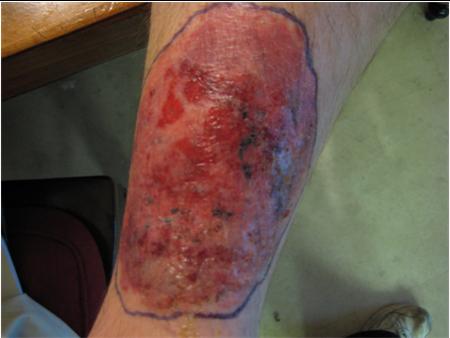

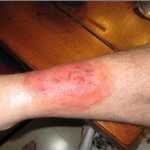
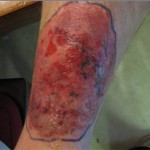
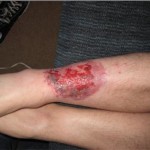
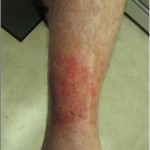
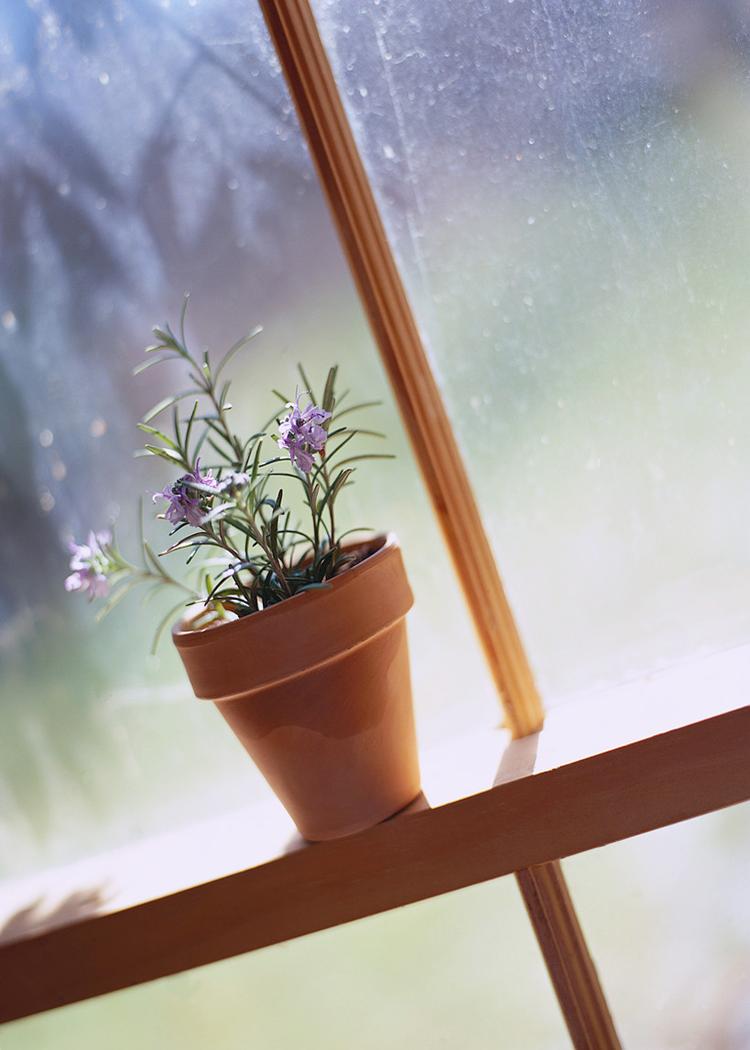




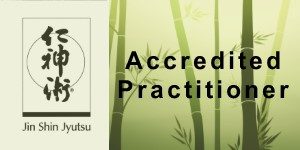



I have had a spider bite where you get the little pimple which itches and you pop it and then it gets bigger. Then it began to turn black or necrose. My bite looked different than yours. I used TKO-Orange on it. It did not hurt or sting when I applied it and I try to keep some on hand. It’s orange oil but it also has some surfacants in it. It seemed to neutralize any venom and arrested the spread. I appreciate seeing the pictures of the hobo bite because we have those in our area also. I would probably try the tko-orange on that bite also but I am glad to read your post on what worked for you. thanks for sharing!
My brother was bitten by a Brown Recluse and his “home treatment” was to rub salt in the wound…common table salt. He said it burned, but apparently, it worked, because he never saw a doctor and the wound healed before it ever became as pronounced as the wound, pictured here.
There are small pockets of accidentally imported BRS type spiders from south america in parts of California. They aren’t native to the area of course, but they are there. There’s actually a few venom scientists tracking them down and catching many of them to collect the venom so they can make a universal BSR anti-venom. To do so they need to have samples from every species and luckily (or unluckily?) many of the foreign species have small populations in Cali, and Florida (yay international commerce).
Very interesting post… but I do believe the hystamine rash was probably related to some of the stuff you were putting on the bite. He probably developed a reaction to one of the ingredients. I’ll just stick to PRID for now, it’s still early days for my bite, no telling if it even is a spider at this point, and at 3 days it doesn’t look nearly as bad as his.
Keep us posted on how things go with your bite. Hope everything is ok.
of course I meant to say brown recluse not hobo. I purposely brought daddy long legs to our house from another location because they were non existent here. It took a couple of years but now there is an army of them. I think I notice less hobo but I still have plenty of the stripe jumpers that like to come in. I have read that spiders do not spread diseases so that’s a plus. While my neighbors spray, etc. I try to look for what mother nature might do. Hope your bite is healing up.
My first “go-to” choice for anything is homeopathy. There is actually a remedy for brown recluse, called “Loxosceles Reclusa”. You won’t find it at the store. I believe we ordered it from http://www.hahnemannlabs.com/. We have the 200C potency on hand. For those who don’t have this particular remedy, Apis or Ledum (depending on the symptoms) should help tremendously. With homeopath, the bite should never get as bad or as long as you dealt with, if taken immediately at the right potency and re-dosed appropriately.
To give you an example of the power of homeopathy, 2 days ago one of my sons got a wasp sting on his finger. We had dealt with a wasp sting last year with this son and did not have these same results b/c we didn’t act quick enough with the RIGHT remedy. This son immediately came to me with a finger that had a red center and a white ring that was very painful, hot and within a few minutes had shooting pain. I started him with Ledum 200C (that’s the usual first choice for stings/bites). It did not stop the shooting pain and when he told me it had progressed from his arm to his armpit, I knew it wasn’t right. Hardly before these pills were dissolved in his mouth, I switched to Apis 1M. Within a few minutes, the shooting pain stopped. Within an hour,it had arrested the swelling and pain. He went to bed, slept overnight, by next morning we couldn’t tell which hand had been bit. I did have to re-dose 1M several times…whenever progress had stopped or regressed. To contrast, his other wasp bite swelled tremendously and took a week or more to clear up.
I would use homeopathy with clay, Vit C, probiotics, warm/cold water soaks, but NOT with any other herbs or essential oils or medicines.
Sherri,
Normally I use homeopathic for many things and was happy to see your recommendation for the treatment of a brown recluse bite. I ordered what you suggested and upon receiving the homeopathic, took the first dose. No problems, but when I took the second dose, I’ve never experienced such horrible pain in my life. Haven’t had the courage to start again either. Have been using poultices of cabbage, apple and potato chopped fine and that seems to at least be keeping this from getting any bigger. Also ordered the Brown Recluse First Aid Kit and while it seems to be somewhat effective, it’s the biggest mess going. Would be great if they could put that stuff in a tube rather than having to mix it yourself. Because of the size of the destruction, about that of a silver dollar, it’s been slow going and the pain is almost constant. Sure does get frustrating. Maybe if one of the 6 doctors that looked at it had figured it out long ago it wouldn’t have gotten to this point. Had the usual, antibiotics, pain pills that didn’t work. Have found several sites, including this one that have been a great help.
I have treated mnay brown recluse spider bites. Down here in TN on the homestead, it just comes with the territory.
What made it sting – was alcohol in the tincture of that kit. I have used it. It is a wonderful extra safegaurd for infection – and maybe wise to endure in advanced bites like yours…but is not required. I shared some of my experience on my own blog here:
http://homeshalom.blogspot.com/2011/07/poisonous-spider-bites-treated.html
I suspect the person who suggested that salt cured his bite, was not biten by recluse…but that is just my opinion. I did not see the bite. 🙂
Thank you for sharing Pamela, I’m so glad you’re safe! 🙂 Love your site!
Several years ago I was bitten by a BRS and an older lady told me a remedy that worked well without leaving a scar or hole. I made a paste of activated charcoal, spread all over my calf on the affected area and redness, covered that with a brown paper bag soaked in red vinegar. I did this for about a week, along with benadryl for the itching. took several weeks to finally heal without signs, but now have no scar.
I wish I could say it was just the alcohol in the tinctures, EVERYTHING makes it burn and sting, doesn’t matter what I put on it. Suddenly there’s a huge amount of pain again. I’m at a loss now as to what to try. Have been using the activated charcoal, but I can’t tell if it’s doing any good. For the last 3 days it’s been no sleep, just pain. Anyone have any other suggestions? Tried the clay, but had to take it off because of pain. I refuse to let the Dr do any cutting, there was talk of taking my big toe off, um, NOT. I can’t wear flip flops if they do that. BTW, I live in a small town in central Cali and I’ve talked to at least a dozen people in this area that have friends or relatives who have been bitten, one poor woman was bitten on the head and has lost her hearing. So, don’t let anyone tell you these little baggers aren’t here.
I’ve had BRS bites twice. The first time was terrible. The swelling burning itching grew exponentially. A friend reccomend a polultice of mashed banana and oatmeal. The first time, because it had progressed over 8/9 days it took longer to heal, changing the bandages 2 and 3 times a day. The second time was just 2 weeks ago and I jumped on it. only needed one application, yet, the site still itched until two days after the scab fell away. Bananas and oatmeal are more affordable and more readily available. Good luck all.
Brown Recluse spiders like it warm, although they are carried in moving vans, etc. out of their normal habitat. Good job in taking care of the would. You have my empathy on what you had to go through.
I had the misfortune of being bitten on my little finger by a BRS spider 12 years ago. It took several months to heal with minimal skin damage, but extremely painful, especially in my finger joints. Every year, without exception, the redness and symptoms return for 3-4 months. I have read the venom stays in the cells and returns from time to time…in my case, every year at the same time. I’ve tried everything under the sun, with nothing really working that well. I’ve had the best luck with oregano oil and tea tree oil. Good luck if you’re dealing with this crazy stuff!
I was bit by a Brown recluse In sacramento and the recluse is here I was told the same thing they rant found in California Oh yes they are…..
I found a map of the brown recluse’s range- it includes California. Find it on the page listed below.
http://www.charcoalremedies.com/brown_recluse
Clearly your conventional Doc took no pains to do any research for you.
Jim Humble’s book on MMS talks about using MMS for BRs along with zinc oxide.